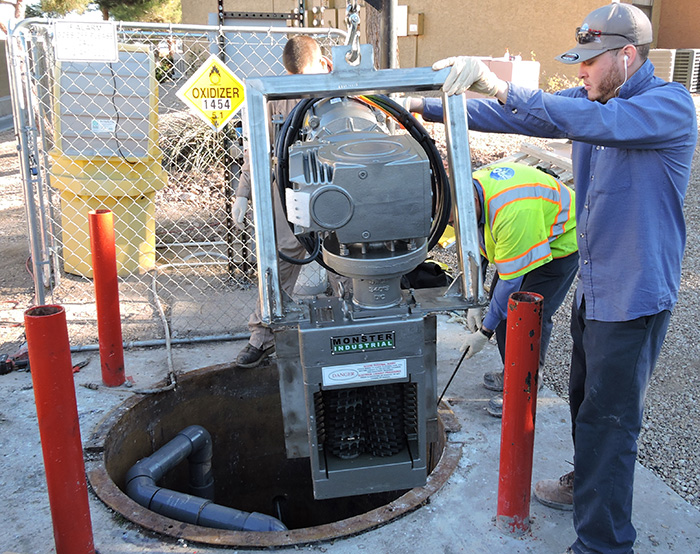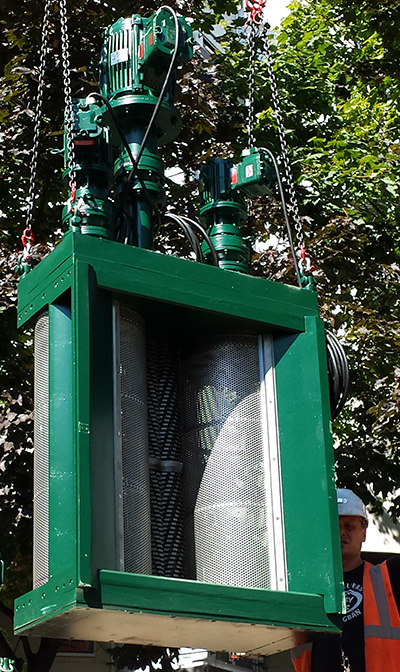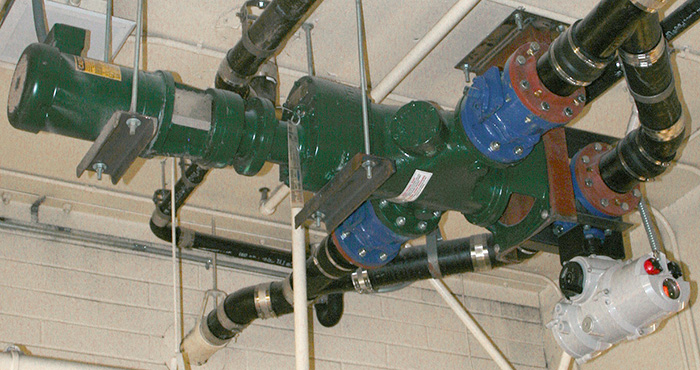It is just past 10 on a Friday night when the phones of the on-call collection systems operators start ringing. It is an alarm for another pump clog at a sewage lift station—the second one in a week.
If this situation sounds familiar, it might be time to retrofit a two-shafted grinder into some lift stations. Every municipality is a candidate for a grinder retrofit, and every municipality has a problem pump station network.
There are several qualifiers that can flag a station as an ideal candidate for a retrofit: an older lift station not designed for higher-solids loading, outdated grinding equipment and, of course, recurring plugs in pumps that require manual cleaning.
 Image 1. A grinder is installed to protect lift station for Las Vegas apartment complex. (Courtesy of JWC Environmental)
Image 1. A grinder is installed to protect lift station for Las Vegas apartment complex. (Courtesy of JWC Environmental)If a station has pumps plugging more than once a week, there is a problem. Some say unplugging a pump anytime is too much.
A grinder can offer the manager of a sewage collections network reassurance that operations will keep moving smoothly day and night. Two-shafted grinders can be retrofitted into the system ahead of the pumps to shred debris before a clog is created.
 Image 2. A grinder is prepared for installation.
Image 2. A grinder is prepared for installation.Why Retrofit with a Grinder?
Many sewage lift stations in service were not designed to deal with the high-solids content found in today’s sewage. The heavy solids loading, often from disposable wipes, can easily overwhelm traditional pumps, including solids-handling pumps. Typically, when operators find their pumps clogging and failing, wipes-related clogging is the reason.
Sewage composition has changed, so the industry standard of the 3-inch spherical solid that pumps were designed to pass no longer meets today’s needs. The addition of a grinder can maximize a pump station’s efficiency while curtailing overtime and unplanned maintenance costs.
Grinding wipes and other waste before they reach the pumps is an effective method for preventing damage, eliminating risk, and reduce the time and energy costs associated with clogging. When the wipes are shredded into small enough pieces they do not reweave, rope together or form cumbersome rag balls in the lift stations, they remain in suspension and can be pumped easily.
 Image 3. A grinder is retrofitted onto the ceiling.
Image 3. A grinder is retrofitted onto the ceiling. Location Is Critical
In a perfect world, every grinder could be retrofitted within the influent pipe or channel to the lift station before sewage enters the wet well. In many cases, however, installing a grinder in the inlet is not possible. In an older pump station, it is likely that no accommodations were considered in the design for installing a sewage grinder.
In a retrofit scenario, a few things must be worked around inside because the structure of the wet well cannot be changed. While space constraints are one of the major factors in a retrofit, grinders can be worked into nearly every station’s configuration. A common technique when retrofitting a grinder is to mount it to the wall of the lift station’s wet well in front of the influent pipe. The engineering process of mounting should consider space constraints, other equipment (like pumps and float switches in the wet well) and accessibility for easy inspection and service. A perfect station does not exist, either in terms of space or flow rates. In heavy storm flow events, an overflow bar rack, which serves as backup, can be beneficial.
Another possible scenario is a lift station wet well that is too small for any additional equipment besides the pumps. In these situations, a simple grinder vault can be added upstream of the wet well in the influent pipe.
Often during a retrofit, prior equipment components can be reused.


